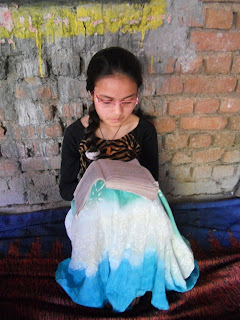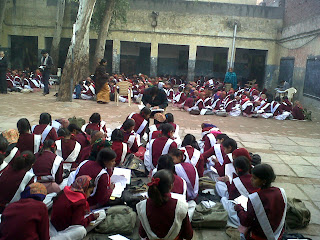When 2% of class VII students cannot read capital letters in English you need to get terribly concerned. But does one? Sadly not because that 2% is not our child or the child of somebody we may know. However the writing is on wall. The ASER (Annual Status of Education Report) for 2012 is out and the results frightening. Class III kids only read class I books, and only 40% of class V students can do a simple division. The findings of the report are scary: basic reading levels showing decline in many states, arithmetic levels also show a decline across most states. And though school attendance is said to be higher. what is the point of an education that does not teach anything. The report goes on to state that there is an exodus towards private schools continues that shows that shows that all is not well in state run schools.
The findings of this report should shock us as it shows that even after more than 6 decades children of Independent India have not been given the right to equitable education and that is truly a shame but I am sure that many of us did not even read the articles that appeared in the press a few days back, or even if we did, it would not have struck a chord as our children mercifully go to swanky private schools. Yet we need to give this a thought and raise our voices. Education is the only way India can change for the better and quite frankly no education seems better than what a large number of children are getting.
I received an email from a lawyer activist who has been relentlessly advocating for better schools in our capital city. He recently visited a school in outer Delhi and “found that hundreds of girl students sitting in ground and on the school roof in open in bitter cold weather. Those found sitting in the classrooms were taking exams in total dark rooms without even electric connections, I am told by the teachers that nearly 1200 girl students are studying in the morning shift and the equal number of boy students are studying in after noon shift. The school appears to be running in a dangerous building for the last three years.” This is totally unacceptable by all standards. What is the use of a right to education if it is not guaranteed by the State. Why should children be studying in the bitter cold or scorching sun or giving examinations in pitch dark rooms. This school has 2400 children who are been denied their right to equitable education.
But they are not the only ones. Many State run schools in our capital city are in a pitiable condition. The schools pwhy children go to are no better. A few months ago our children were brave enough to highlight this reality in a postcard campaign and face the music thereafter. But in hindsight it was a good move as some things did change for the better. This once again proves that nothing comes easy in our great democracy. Our ‘rulers’ are masters at making laws that sound good on paper but meet many obstacles when implemented. Many of these pertain to education.
Let us begin with the decision of doing away with class X Boards and introducing ‘continuous comprehensive evaluation’ which is supposed to have inbuilt flexibility for schools to plan their own academic schedules as per specified guidelines. Sounds great does it not? But to enable proper implementation of this scheme you need teachers who are capable of coming up with innovative ways. This may happen in ‘good’ schools but what about Government schools with 100+ children per class and unmotivated and even brutal teachers. For such a scheme to be successful, one should have first created the resources needed. As I said it looks good on paper! Seems that is all the lawmakers want. Never mind what happens on the ground. The same can be said about the ‘no fail policy’ till class VIII. Whereas public schools will ensure that their students meet the required standards in each class, Government schools simply promote their kids from class to class and that is why we have class V or VI or VII kids unable to read or solve a basic arithmetic sum. We have had many suck kids come to pwhy. Mercifully continued support has helped them bridge the gap and perform well. This is heartwarming as well as disheartening as one thinks of the millions of kids who cannot get the support they need and hence may simply drop out and never get the education they aspire for. And even the doing away of the Xth Boards seems to be have been a wrong move as many class XII students feel they would have been better prepared had they sat for the Xth Boards. The changes heralded 3 years ago seem to have somewhat failed. And though a CCE approach seems to help average students, it is a failure in a mark oriented system. Such changes should only be made once all needed resources are in place. The reality is grim: of the 800 000 aspirants who sat for the Central Teachers Eligibility Test in December, only 1% cleared the test! This exam is mandatory for teaching class I to VIII and is taken by those who have cleared their BEd! Alarming to say the least. If you are interested you can view some of the papers here.
Now let us talk about the RTE Act and some of its aberrations. First and foremost free education is only for children between 6 and 14. Why not till the end of of schooling? At 14 a child is somewhere around class VIII. Now with the no fail policy you can imagine what kind of education an underprivileged child will have! But that is not what I consider the weakest point to me. For me, if free and quality education is the right of every child born in India, then it is the Sate’s duty to run enabling quality schools in each and every neighborhood. The 25 % reservation for economically disadvantaged children in ALL private schools is an abdication of the state’s responsibility and an easy way out. Makes one feel that children have the lowest priority in all decisions! The drawbacks of this approach are many. First and foremost we all know that these seats will never go to the true beneficiaries. We all know how easy it is to get all sort of false certificates! I know of financially sound middle class parents who have availed of this though they could well afford to pay for their children. I am sure that a survey of the social profiles of children admitted under this category would show that it is not the poorest of the poor who are now in swanky schools. The poorest of the p[oor, if in school, are forced to attend crowded state run schools with scant facilities. This whole approach to quality education is wrong. The state has chosen a backdoor option that reeks of reservation. Why should kids be branded! And what about the zillions of children who cannot avail of this facility. Where is their right to quality education? Not to mention the question that beg to be asked: what after the child reaches the age of 14!
That the system is flawed is evident in what is happening today to children seeking Nursery admission. Nobody seems to know what is happening! It is time we all lend our voice to this cause! Will we?



